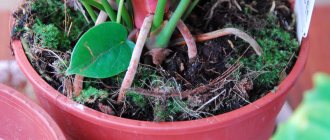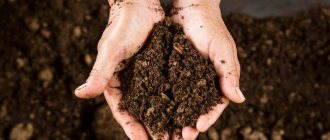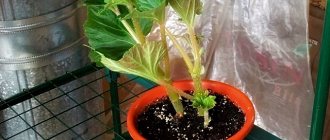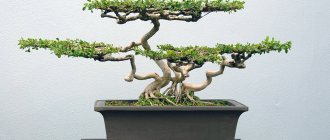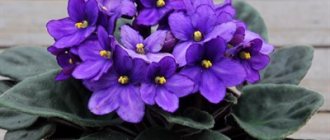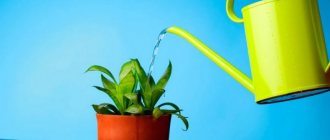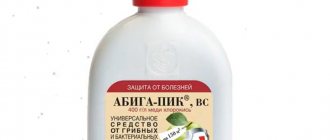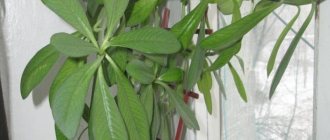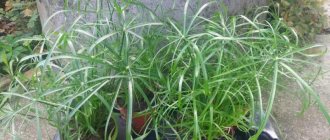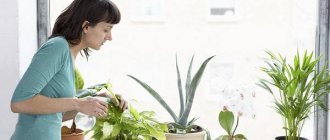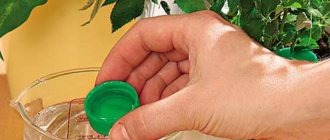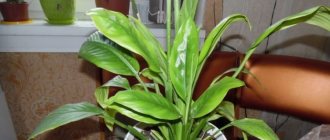When growing flowers indoors, you need to carefully take care of your green pets so that they feel as comfortable as possible indoors. It is advisable to create conditions close to the natural habitat. To do this, you will need to maintain the temperature in the room, air humidity, and also choose the right soil for the plants, which would combine exactly the qualities that this particular flower or shrub needs. Although in flower shops you can find bags of universal planting material that will suit most green pets. Read our article about what kind of soil is needed for planting indoor plants and how to correctly classify the types of substrates.
Heavy ground
This type of soil is best suited for growing large plants with a developed root system located at great depths. Among such representatives, the most common are clivias, dracaenas and palm trees. As a rule, this garden mixture is prepared from three components:
- 5 parts turf soil;
- 1 part coarse sand;
- 1 part humus.
Knowing the preferences of indoor plants regarding the quality and composition of the substrate, it can be prepared at home. All components are prepared independently or purchased at any specialized store.
5.Preparation of the soil mixture
Since components taken from nature will in any case contain possible pathogens and insect larvae, they must all undergo a sterilization procedure before use. An exception to this rule is purchased soils from large and reliable manufacturers - they are disinfected at the production stage and do not require additional treatment. Sterilization of such mixtures will even be harmful - after all, many manufacturers currently add living beneficial microorganisms to soil mixtures, and during sterilization they die.
Before use, soil taken from the street should be steamed in a water bath or heated in an oven at a temperature of about 80°C for an hour. In order to prevent mold fungi from appearing when using such a soil mixture, such soil is additionally watered for a month with a weak solution of potassium permanganate.
Medium soil
Most representatives of indoor plants prefer this type of soil, since its composition is optimally balanced. Such a soil mixture can be made from the following components:
- 1 part peat;
- 1 part sand;
- 2 parts humus;
- 2 parts of turf land.
If you decide to prepare the substrate and soil for plants with your own hands, then it is worth noting that all components must be of proper quality. You should also observe all proportions correctly, because with the slightest mistake, the root system of your indoor pet can be affected by rot, which will be almost impossible to get rid of.
1. Main characteristics of soil mixtures
The basis for a healthy and attractive appearance is a properly selected substrate.
Here are the main features of a good substrate:
- The soil should be sufficiently permeable, but at the same time retain some moisture.
- The soil must be stable - do not use quickly decomposing substrates for growing flowers.
- The substrate must retain nutrients and release them to the plants in a timely manner - minerals should not fall into the pan during watering.
- The soil should not contain seeds of foreign herbs and pathogens.
- pH values must be within the limits recommended for growing specific types of plants.
Most houseplants grow best in rich, well-drained soil. One of the best compositions is considered to be one that allows moisture and air to pass through to the roots, has moisture-holding capacity and nourishes plants with essential minerals. Many mixtures contain perlite or coarse river sand to prevent moisture from stagnating in the substrate.
Some gardeners prefer purchased soils of certain brands, while others make up their own mixtures based on the specific needs of each plant. In any case, it is worthwhile to dwell in detail on the components of any soil for plants.
↑ Up,
Light soil
This soil is best suited for growing small flowers that have a shallow root system. Popular representatives include: gloxinia, cyclamen, begonia and aloe. Also, such a substrate can be successfully used for growing seedlings and for rooting cuttings. With the standard preparation scheme, you need to mix the following elements:
- 1 part sand;
- 1 part humus;
- 1 part leaf soil;
- 3 parts peat.
Before connecting all components, it is recommended to thoroughly sift the soil to remove foreign bodies. Otherwise, small stones and twigs will interfere with the proper development of the root system. Remember that the soil must be clean, airy and loose.
Content
- 1. Soil characteristics
- 2. Soil composition 2.1. High peat
- 2.2. Lowland peat
- 2.3. Vermicompost
- 2.4. Sod land
Finding the perfect soil for your favorite indoor flora is like searching for the mystical “Holy Grail” that will instantly make the plant bloom in a lush bouquet.
In reality, the search and selection stories are more similar to fishing ones: if your neighbor is biting (read: grows/blooms better), then his worm (soil) is better. However, the truth is often not buried in the soil, although it is one of the four pillars of proper plant growing, along with lighting, watering and care. What soil is the best? The answer to this question depends on what plant you have on your windowsill. The best soil for an azalea is the worst soil for a desert cactus. Both will be completely unsuitable for aquatic plants. And some plants do not need soil at all (for example, epiphytic orchids or the aerophyte Tillandsia osniformes). However, if we don’t touch exotics, then almost all soils have characteristics that unite them, knowledge of which will help you find the right soil among similar ones specifically for your plant.
Substrate structure
The characteristics of soil for indoor plants include two main parameters that you should pay attention to first - acidity and structure. The composition of purchased substrates can be very different. It is simply impossible to determine by eye whether the contents of the packages correspond to the composition indicated on the packaging. In this regard, when assessing the quality of the proposed substrate, it is necessary to focus on easily recognizable and always visible characteristics, for example, the presence or absence of structure.
The soil for indoor plants (flowers, vines, shrubs, etc.) should have a pronounced structure, that is, the presence of some rough texture, heterogeneity and lumps. This can be easily checked by feeling the substrate bag with your hands. In such soil, plants will never suffer due to dry “layers” that form on the surface of the flowerpot as a result of soil drying out. In soil with a pronounced structure, moisture will be evenly distributed and retained in any part of the substrate. It also retains its breathability even several years after planting, since the upper layers of the soil are not corroded and compacted. At the same time, substrates that have a too uniform composition are more prone to acidification, as well as uneven distribution and retention of moisture.
Sandy loam
In terms of mechanical composition, this soil variety is light and has significant similarities with sandy soil. We can distinguish sand even visually, and the formed soil ball is deformed with slight pressure.
Composition of sandy loam soil:
- the clay component accounts for only 20-40%
— the remaining 60-80% is sand
- has a variety of minerals, including quartz
Positive qualities characterizing sandy loam soil:
- has a positive effect on plant development due to the rapid decomposition of organic soil components.
- When dry, cracks and crusts do not appear on the surface of the earth.
- lends itself well to aeration and warms up quickly.
- the root system is rarely affected by rot, since there is no stagnation of water.
- It is lightweight and easy to process.
- allows you to retain nutritional components at the roots for a long time.
- at low temperatures, the soil can remain warm for a long period.
- has a high level of moisture absorption and oxygen saturation.
- saturates the root system with a sufficient amount of moisture due to the slow passage of water through the soil.
- there is no tendency to form earthen lumps.
The negative aspects of the soil include:
- nutrients go into the clay layer during watering and during rain, which leads to insufficient nutrition of the root system.
- not strong enough structure. Humus components in the surface layer, even with a slight wind, are easily dispersed after drying.
- the lightness of the soil in the upper layer does not retain the mineral component of the fertilizer well.
What plants can be planted in sandy loam
1. Coniferous trees and shrubs - European larch, pine, cypress, spruce, fir, bush juniper mostly grow without loss.
2. Fruit tree can also be planted in this soil. The recommended variety with high yield is Japanese quince.
3. Vegetables and herbs - tomatoes, celery, all varieties of cabbage, cucumbers, cilantro, dill and parsley. But planting plants in the ground should be done a little deeper.
4. Handicraft and decorative flowers – white svida, barberry, bush dosiphora, hawthorn, gorse. Suitable annual flowers include sweet peas, wolf bean, iris, garden purslane, decorative beans, small-flowered marigolds, double-pinnate cosmos, calendula, capuchin. The following perennial plants can be planted in sandy loam soil: thyme, cornflowers, chives, herbal cloves, sage, cut grass, chamomile aster, tansy, and ornamental grasses.
5. Grapes of Rkatsiteli, Alepo and Pino varieties.
Soil acidity
Determining the composition of soil for indoor plants is not so difficult, but what to do with acidity? Even in universal substrates, this parameter must be indicated on the package with soil, since most indoor crops have their own individual characteristics, which are by no means uniform in their requirements for soil reaction. Of course, most plants will thrive in a neutral environment, but there are also representatives that develop exclusively in soil with an alkaline or slightly alkaline reaction, as well as species that require an acidic environment.
For indoor flowers, the average acidity value is 6.0 on the pH scale (neutral environment). Soils with a pH of 7.0 and above are alkaline or calcareous, and substrates with a pH of 5.5 and below are classified as slightly acidic or acidic.
Very few indoor plants prefer alkaline soil. Among the prominent representatives: chlorophytum, ophiopogon, calceolaria and bells.
Soil for indoor plants and flowers with a reaction of 5.5 pH will be optimal for cyclamen, cestrum, sansevieria, pittosporum, pachyphytus, ferns, wood sorrel, dieffenbachia, cypress, cordyline, calla lilies, camellia, gerbera, alocasia, acalypha and others. A substrate with a pH value of 4.0 to 5.0 is preferably used for bergeranthus, hydrangea, zuphorbia, oscularia, ceropegia, rhododendron, etc.
In the description of any indoor plant, in addition to the replanting strategy, as well as optimal maintenance conditions, you can find the preferred composition and structure of the soil. If you decide to determine which soil composition is best for flowers, then you should not settle for the “average” option, since for each pet you need to choose your own substrate, based on the individual preferences of a given plant. Of course, most crops will prefer a nutritious, loose and universal type of substrate with a neutral environment, however, in indoor collections there are often species for which such soil will be destructive.
Acidic or alkaline?
When do we face the issue of soil selection? When we replant flowers or plant them in a permanent place. If you have such a question, first decide which of the main groups your pet belongs to. Plants are distributed in relation to the acidity of the soil. After all, the mixture can have either an alkaline or acidic reaction. But not everything is so simple either.
For example, some flowers require slightly acidic soil, others medium acidity, and still others will look good if planted in acidic soil. The same goes for alkaline soils. Give some slightly alkaline soil, and others with a pronounced alkaline reaction. There are also supporters of neutral soil, and some plants weaken in it.
Therefore, to select the soil, first find out what reaction your flower needs.
- Photos of aloe species with names
Soil of medium acidity or acidic (pH = 4.5 - 5.5): azaleas, calla lilies, heather, camellias, hydrangeas, anthurium, monstera, rhododendron, ferns, fuchsia.
Slightly acidic soil (pH = 5.5 - 6.5): asparagus, begonia, pelargonium, primroses, abutilon, amaryllis, tradescantia, aralia, ficus elastica.
Neutral soil (pH = 6.5 - 7): roses, cineraria, saxifraga, gillyflower or matthiol, chrysanthemums.
Alkaline soil (pH = 7): heliotrope, calceolaria.
At home, soil acidity can be easily checked using litmus paper.
Universal primer
When choosing a soil composition for plants, you need to pay attention not only to the acidity indicator, which must be indicated on the packaging, but also to the suitability of the substrate for a particular type of plant - in most cases, the list of crops will also be given on the package with planting material. Also, do not forget that you can get advice on the suitability of a particular type of soil from a sales consultant who will help you make your choice.
A single, or universal, complex earth mixture is most often found on sale. Manufacturers can call it whatever they want - from the usual “soil” to clever brand names. This soil is considered suitable for various groups of plants due to its “average” characteristics. Most unpretentious indoor crops that do not require special care will happily live in it.
Clayey
Clay mail contains 20% sand and 80% ordinary clay, and its color is red or brownish. If the sausage formed from wet soil does not crumble during the process and there are no cracks on it, then we can say with confidence that the soil is clayey.
Advantages of this soil:
- ability to retain water for a long period.
- Compared to other soil varieties, it has a high level of enrichment with nutritional components.
The soil also has a number of disadvantages :
- disruption of air circulation due to increased soil density.
- At elevated temperatures, the earth becomes hard and cracks form.
- poor thermal conductivity, which increases the period of seed growth.
- low moisture absorption properties.
- due to stagnation of water, there is a high probability of rot on the roots.
- difficulties in processing.
It is optimal to grow in clay soil
— ornamental trees – birch, bird cherry, willow and maple; Coniferous trees include spruce, thuja and juniper.
- vegetable crops - beets, Jerusalem artichokes, potatoes, peas.
- berry bushes and fruit trees - cherry, gooseberry, apple tree, currant, plum, raspberry, pear, blackberry.
- flowers - Volzhanka, iris, rose, cranebird, turtledove, hosta.
Special types of substrates
Special substrates are soil mixtures developed and selected for a specific family, species or type of indoor plants. A distinctive feature of such soil is its narrow directionality. These earthen mixtures differ from universal ones not only in their structure and acidity, but also in varying degrees of nutritional value, which is achieved thanks to additional additives in the form of sphagnum or pine bark. Such compositions are always better than universal ones, since they truly satisfy all the needs of indoor crops. However, choosing this type of substrate will be extremely difficult, so first you need to familiarize yourself with information about the plant itself.
Special substrate types include:
- soil for violets;
- soil for growing indoor roses;
- substrate for tubs, jasmine, citrus;
- soils for palm trees (in rare cases you can find separate mixtures for dracaena and yucca);
- soil for succulents and cacti;
- soil mixtures for decorative deciduous and decorative flowering plants.
Moreover, ready-made soil for plants of narrow specialization is perfect for representatives who have similar soil requirements. For example, almost all Gesneriaceae will feel great in soil for violets, and soil for yucca or dracaena is also suitable for hibiscus. But orchid soil is a highly specialized substrate that can only be used for orchids.
Additional components
As was said at the beginning, all components of a multi-component soil for indoor plants fall into the categories of basic and additional.
Additional components are not required in the soil mixture, but can significantly improve the quality of the soil, and at the same time help the plant remain healthy and strong.
Most recommended by experts as additional ones for creating a high-quality soil mixture:
- horn meal - These are the horns and hooves of cattle crushed into powder, which in this form have proven themselves to be excellent as a phosphorus fertilizer. You may also come across horn shavings, but their action is slower, and therefore flour is preferable for indoor plants. It can be used both in dry form - added to the soil at a rate of 1:30, and (less often) in liquid form - soak 1 kg of flour in 1 liter of water.
- sphagnum - a substance close to peat, moss that grows in swamps. It is from sphagnum that high-moor (as we remember, acidic) peat is formed. Other names: sphagnum moss, peat moss. Loosening the soil, at the same time it is able to retain moisture in it. And since it has a low pH value - only 4, it contributes to the oxidation of the soil to a certain extent.
- wood ash - on the contrary, when added to the soil, it reduces its acidity, therefore it is also used as a regulator of this indicator. And also - as a potassium fertilizer. In addition to potassium, it contains iron, phosphorus, magnesium and other microelements beneficial for plants. Like horn flour, it can be added to the soil in dry form, but in a ratio of 1:50, or in liquid form - water the plant every 10-14 days with a composition of 25 grams. (or 3 tablespoons) of ash, infused for a week in 1 liter of water.
- charcoal - an excellent “doctor” for plants: in case of rotting of the roots, it is added in small quantities to the soil during plant replanting, and it is also sprinkled on wounds on any parts of the plant. Charcoal also helps loosen the soil and increases its moisture permeability. It is sold in the “flower” departments of stores, however, in the absence of a special one, charcoal for grilling is also suitable, but it will need to be crushed into small (up to 1 cm) pieces. In the most extreme case, charcoal, like ash, can be burned yourself.
- conifer bark - a desirable soil additive for orchids, epiphytes, ferns and anthuriums. Usually prepared on its own. To do this, the bark in the required amount is removed from old pines or spruces, crushed and pre-boiled for half an hour in water. Then it is added to the soil mixture.
Read also: Is it possible to prune trees?
Sod land
The result of overheating of turf layers is quite nutritious soil. To prepare the substrate, you need to put the grass in a pile, then cover it with a layer of cow manure. All that’s left to do is wait until this “pie” gets overcooked. The substrate is used for planting plants that prefer acidic soils, since turf soil has an acidity of 5 to 6 pH. In order to reduce the reaction, as well as to give the substrate a looser structure, turf soil is often mixed with other types of soil, as well as sand or clay.
Types of soils for decorative gardening
Depending on the type of crop, such gardening requires special soils. Land from a summer cottage is not suitable for this option, since it does not contain those components that are needed by ornamental plants of various types. For this reason, it is necessary to prepare or buy special nutrient mixtures that combine all the necessary components for optimal development of seedlings.
Sod land
It is prepared from the top layer of the earth, which contains nutrients, and the soil itself is porous. It is better to take this soil in areas where leguminous plants grew. The soil is not suitable for lowland areas due to acidity. It needs to be harvested in the spring, so that it will lie in piles and rot during the summer. In autumn, the turf soil needs to be sifted.
Humus soil
Its basis is rotted manure. It contains a large number of nutritional components. To ensure that the humus is of good quality, fresh manure should be stacked. It must be kept moist, plus it will also have to be shoveled several times. If the stack is prepared in the spring, then the land will be ready by the end of the next season.
Leaf ground
It is obtained through the process of rotting leaves (grass). It is necessary to collect forest leaves, rake them into a pile, compact them. In summer they should be wet all the time. Such soil will be ready for use in 2 years.
From these components you need to prepare an earthen mixture for ornamental crops of various types. In addition, sand must be present in any substance. Its proportions vary depending on the type of plant for which the nutrient mass is being prepared.
Leaf ground
Perhaps the lightest and loosest soil for plants. The mixture of substrate, which contains leaf soil, perfectly allows water and air to pass to the root system, but its nutritional value is at an average level, since such planting material is obtained as a result of the rotting of simple leaves from deciduous trees. They are harvested in small heaps in the fall and left for a period of one to two years. To make the process of overheating go faster, the layers of the heap must be constantly watered and turned over. Leaf soil can be used to enhance the acid reaction.
Chernozem
This is the best rock, formed by the rotting of plant residues (humus). rich in essential elements of natural origin: phosphorus, sulfur, nitrogen, iron. The soil has a granular or lumpy structure and is close to black in color. The degree of color is affected by the amount
humus in the composition. From 9–15% – black, dark gray – 6–9% (medium humus), gray – 1–6%. Fertility indicators also decrease.
The formation of chernozem occurs over thousands of years. The characteristics of this soil are so high that it has no analogues. It is not possible to create it artificially, because the conditions necessary for the process are unique in laboratory conditions.
Chernozem is often confused with dark soil used in construction (foundations, roads). It’s very easy to check - squeeze a handful in your hand into a lump. The black soil should become like clay and harden after drying. The soil will crumble when compressed.
Peat land
This land differs from others in its particular lightness and friability. This is what is most often used to improve the overall soil composition. Peat mixture provides mineral balance for any soil mixture. It is obtained exclusively from peat, which has gone through a period of decay at least a year ago. In gardening, high-moor peat is most actively used, and less often, dark transitional peat, which has an acidity of 3.5 to 5.5 pH. If there is peat in the mixture, then you should definitely see fibrous reddish pieces in it. This soil is best suited for growing young seedlings, especially all aroids. Ferns and philodendrons can even live in clean peat. However, in order for the soil to better allow water and air to pass through, it is recommended to mix it with other types of soil.
What does it offer?
- Soils with quality certificates of the Moscow Environmental Register (MED)
- 3 own bases in the north and south of Moscow with a large supply of different types of soil for gardening and planning work
- Possibility to come to the base at any time to see the assortment and evaluate its quality
- Shipment by scales 24/7
- Soils in bulk, in bags of 25 and 50 kg and in big bags
- Same day delivery
Buy soil and bulk building materials from companies that give you guarantees. Ask the seller for the addresses of bases, stores, warehouses, ask to send a photo of the product before ordering and paying. An extra couple of hours spent searching for a reliable supplier and checking will save you money, time and stress. And there are no more valuable resources.
Check out all types of soils here https://eko-crushed stone.rf/grunty
Coniferous land
This variety of acidic light soil is perfect for growing flowering indoor plants, such as azaleas and anthuriums. The soil is the top layer of litter taken from a coniferous forest (usually pine). If you decide to prepare soil for plants yourself, then you should know that you do not need to remove the layer from the very top, since there are many unrotted needles there. It is best to use the bottom layer, which is located at a depth of 20 centimeters. This is a fairly loose soil with a reaction of 4 to 5 pH.
Ambiguous words
So, when they talk about " soil
", then this word can mean the following concepts:
- the upper layer of the earth's crust containing rotted remains of organisms;
- “bottom” of a mine working;
- term in heraldry;
- river in Siberia.
«Earth
" is a much more ambiguous word, and it is hardly advisable to give all its meanings. Let's remember the most popular:
- our planet;
- the surface layer of the earth's land (this is what it has in common with “soil”);
- land as opposed to the ocean;
- traditional translation into Russian of the names of administrative-territorial units of many states.
What is the difference between earth and soil, if in both cases we mean the top layer of land on which everything grows? There is no difference, these are synonyms. Specialists (soil scientists, agronomists, etc.) usually use the word “soil”. Everyone else says “earth”.
Bark
In most cases, gardeners use exclusively pine bark. It can be collected right in the forest. To disinfect and soften the material, boil it for 30 minutes in boiling water, after which it is cut into small pieces. The bark will give the substrate good water permeability, as well as lightness. It will also provide an acidic reaction for the mixture (4-4.5 pH). Pine bark is also used to make the soil for plants more loose. This property is especially required by aroids, ferns and, most of all, orchids.
conclusions
So, if we return from Mars to the sinful Earth and consider any one and the same piece of lawn from the point of view of the terms that interest us, then the following immediately becomes obvious:
- Looking at it as “soil,” we consider it primarily from an engineering-mechanistic (economic) point of view (most often as a potential object in engineering and construction activities).
- Considering it as “soil,” we are primarily interested in its fertility relative to the plant that will be grown on it in the future (it is important to understand that the requirements of different plants for soil fertility can be different and generally highly specific).
Sphagnum (moss)
This is an indispensable component of the soil mixture for epiphytic plants. Moss is used to make the soil light, loose, and hygroscopic. However, before use, it must be dried well and then ground almost into powder. Sphagnum moss will give an acidic reaction around 4 pH. Moss is also perfect for covering the aerial roots that are located on the trunks of some plants, so that they do not dry out or freeze. It is also better to cover buried branches (during propagation) with fresh moss.
The information from the article will help you properly prepare soil for your pets and answer the question of what kind of soil is needed for planting indoor flowers. Remember that not all crops prefer to “live” in universal soil, so before replanting it is better to consult with a specialist in a flower shop or find information in the relevant literature.
Land resources in human life
Land resources are lands used by humans in economic activities.
Land resources are determined according to several criteria. The relief of a particular area plays a huge role. It may be convenient, inconvenient or unsuitable for a particular activity. Lowland areas are suitable for the cultivation of cultivated species or certain cultivation. Mountainous and hilly terrain is not convenient enough for irrigation or fertilization of plant species. And there are territories in which it is impossible to engage in any purposeful activity - dissected ravines, rocky hills, swamps and others.
The fertility of land resources is also important for human activities. A good soil cover will be able to nourish all plants with a sufficient amount of necessary substances and elements.
Soil and land resources play an important role in human life. It is from the soil that we get everything we need for life - food resources.
Land resources help in carrying out agricultural activities and forestry. The earth is also a source of building materials, thanks to which modern structures are built.
